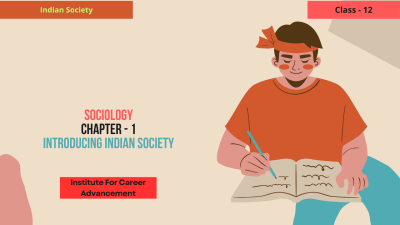Introducing Indian Society - Class 12
 Compare
Compare
Introducing Indian Society is a Class 12 course designed to provide students with a comprehensive understanding of the diverse social, cultural, and historical aspects of Indian society. It aims to foster critical thinking, empathy, and a sense of belonging to the Indian nation.
Key Topics:
Indian History: A brief overview of India's ancient, medieval, and modern history, focusing on significant events, cultural developments, and social changes.
Indian Geography: An exploration of India's diverse geographical features, including its physical landscape, climate, and natural resources.
Indian Culture: A study of India's rich cultural heritage, encompassing its languages, religions, arts, music, literature, and traditions.
Social Structure: An analysis of the social structure of Indian society, including caste, class, gender, and tribal communities.
Economic Development: An examination of India's economic history, challenges, and opportunities.
Political System: A study of India's democratic system, including its constitution, government structure, and political parties.
Social Issues: A discussion of contemporary social issues in India, such as poverty, inequality, education, healthcare, and environmental concerns.
Learning Objectives:
Develop a deep understanding of India's historical, cultural, and social context.
Appreciate the diversity and complexity of Indian society.
Analyze social issues and their impact on individuals and communities.
Develop critical thinking and problem-solving skills.
Foster empathy and respect for different cultures and perspectives.
Introducing Indian Society is a valuable course that helps students develop a strong foundation in Indian studies. It equips them with the knowledge and skills necessary to engage in informed discussions about India's past, present, and future.
ইন্ডিয়ান সোসাইটির পরিচয় একটি দ্বাদশ শ্রেণির কোর্স যা শিক্ষার্থীদের ভারতীয় সমাজের বিভিন্ন সামাজিক, সাংস্কৃতিক এবং ঐতিহাসিক দিকগুলি সম্পর্কে ব্যাপক ধারণা দেওয়ার জন্য ডিজাইন করা হয়েছে। এর লক্ষ্য হল সমালোচনামূলক চিন্তাভাবনা, সহানুভূতি এবং ভারতীয় জাতির সঙ্গে একাত্মতার অনুভূতি গড়ে তোলা।
মূল বিষয়ঃ
ভারতীয় ইতিহাসঃ ভারতের প্রাচীন, মধ্যযুগীয় এবং আধুনিক ইতিহাসের একটি সংক্ষিপ্ত বিবরণ, উল্লেখযোগ্য ঘটনা, সাংস্কৃতিক উন্নয়ন এবং সামাজিক পরিবর্তনের উপর দৃষ্টি নিবদ্ধ করে।
ভারতীয় ভূগোলঃ প্রাকৃতিক প্রাকৃতিক দৃশ্য, জলবায়ু এবং প্রাকৃতিক সম্পদ সহ ভারতের বৈচিত্র্যময় ভৌগোলিক বৈশিষ্ট্যগুলির একটি অন্বেষণ।
ভারতীয় সংস্কৃতিঃ ভারতের ভাষা, ধর্ম, শিল্প, সঙ্গীত, সাহিত্য এবং ঐতিহ্যকে অন্তর্ভুক্ত করে ভারতের সমৃদ্ধ সাংস্কৃতিক ঐতিহ্যের একটি অধ্যয়ন।
সামাজিক কাঠামোঃ বর্ণ, শ্রেণী, লিঙ্গ এবং উপজাতি সম্প্রদায় সহ ভারতীয় সমাজের সামাজিক কাঠামোর একটি বিশ্লেষণ।
অর্থনৈতিক উন্নয়নঃ ভারতের অর্থনৈতিক ইতিহাস, চ্যালেঞ্জ এবং সুযোগগুলির একটি পরীক্ষা।
রাজনৈতিক ব্যবস্থাঃ সংবিধান, সরকারী কাঠামো এবং রাজনৈতিক দলগুলি সহ ভারতের গণতান্ত্রিক ব্যবস্থার একটি অধ্যয়ন।
সামাজিক সমস্যাঃ দারিদ্র্য, অসমতা, শিক্ষা, স্বাস্থ্যসেবা এবং পরিবেশগত উদ্বেগের মতো ভারতের সমসাময়িক সামাজিক সমস্যাগুলির একটি আলোচনা।
শিক্ষার উদ্দেশ্যঃ ভারতের ঐতিহাসিক, সাংস্কৃতিক ও সামাজিক প্রেক্ষাপট সম্পর্কে গভীর বোধগম্যতা গড়ে তোলা।
ভারতীয় সমাজের বৈচিত্র্য এবং জটিলতার প্রশংসা করুন।
সামাজিক সমস্যা এবং ব্যক্তি ও সম্প্রদায়ের উপর তাদের প্রভাব বিশ্লেষণ করুন।
সমালোচনামূলক চিন্তাভাবনা এবং সমস্যা সমাধানের দক্ষতা বিকাশ করুন।
বিভিন্ন সংস্কৃতি ও দৃষ্টিভঙ্গির প্রতি সহানুভূতি ও সম্মান গড়ে তুলুন।
ভারতীয় সমাজের পরিচয় দেওয়া একটি মূল্যবান কোর্স যা শিক্ষার্থীদের ভারতীয় অধ্যয়নে একটি শক্তিশালী ভিত্তি গড়ে তুলতে সহায়তা করে। এটি তাদের ভারতের অতীত, বর্তমান এবং ভবিষ্যৎ সম্পর্কে অবহিত আলোচনায় জড়িত হওয়ার জন্য প্রয়োজনীয় জ্ঞান এবং দক্ষতার সাথে সজ্জিত করে।




















